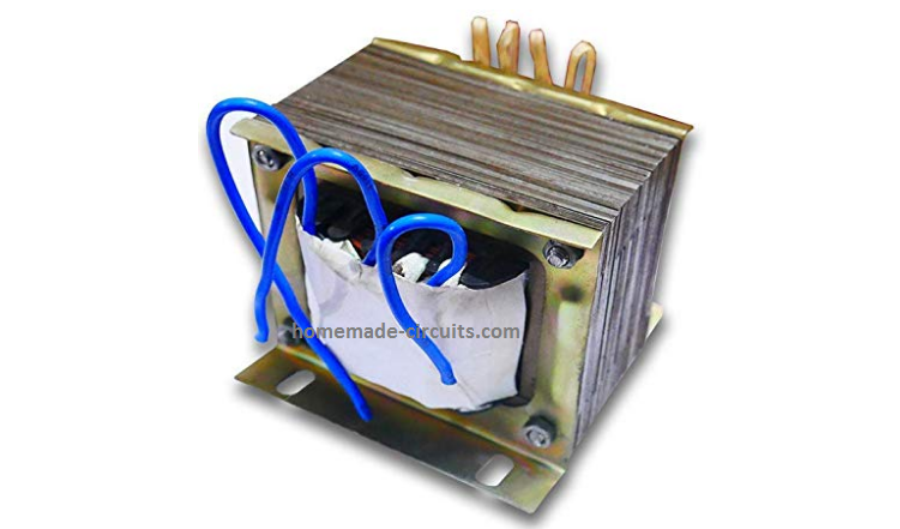How to Design Your Own Inverter Transformer
Designing an inverter transformer can be a complex affair. However, using the various formulas and by taking the help of one practical example shown here, the operations involved finally become very easy.
The present article explains through a practical example the process of applying the various formulas for making an inverter transformer.The various formulas required for designing a transformer has been already discussed in one my previous articles.Update: A detailed explanation can be also studied in this article: HOW to make transfomers
Designing an Inverter Transformer

An inverter is your personal power house, which is able to transform any high current DC source into readily usable AC power, quite similar to the power received from your house AC outlets.
Although inverters are extensively available in the market today, but designing your own customized inverter unit can make you overwhelmingly satisfied and moreover it's great fun.
At Bright Hub I have already published many inverter circuit diagram, ranging from simple to sophisticated sine wave and modified sine wave designs.
However folks keep on asking me regarding formulas that can be easily used for designing a inverter transformer.
The popular demand inspired me to publish one such article dealing comprehensively with transformer design calculation. Although the explanation and the content was up to the mark, quite disappointingly many of you just failed to grasp the procedure.
This prompted me to write this article which includes one example thoroughly illustrating how to use and apply the various steps and formulas while designing your own transformer.
Let’s quickly study the following attached example:Suppose you want to design an inverter transformer for a 120 VA inverter using a 12 Volt automobile battery as the input and need 230 Volts as the output. Now, simply dividing 120 by 12 gives 10 Amps, this becomes the required secondary current.
Want to lead you how to design basic inverter circuit
In the following explanation the Primary Side is referred to as the Transformer side which may be connected at the DC Battery side, while the Secondary side signifies the Output AC 220V side.
The data in hand are:
- Secondary Voltage = 230 Volts,
- Primary Current (Output Current) = 10 Amps.
- Primary Voltage (Output Voltage) = 12-0-12 volts, that is equal to 24 volts.
- Output Frequency = 50 Hz
Calculating Inverter Transformer Voltage, Current, Number of Turns
Step#1: First we need to find the core area CA = 1.152 ×√ 24 × 10 = 18 sq.cm where 1.152 is a constant.
We select CRGO as the core material.
Step#2: Calculating Turns per Volt TPV = 1 / (4.44 × 10–4 ×18 × 1.3 × 50) = 1.96, except 18 and 50 all are constants.
Step#3: Calculating Secondary Current = 24 × 10 / 230 × 0.9 (assumed efficiency) = 1.15 Amps,
By matching the above current in Table A we get the approximate Secondary copper wire thickness = 21 SWG.
Therefore the Number of Turns for the Secondary winding is calculated as = 1.96 × 230 = 450Step#4: Next, Secondary Winding Area becomes = 450 / 137 (from Table A) = 3.27 sq.cm. Now, the required Primary current is 10 Amps, therefore from Table A we match an equivalent thickness of copper wire = 12 SWG.
Step#5: Calculating Primary Number of Turns = 1.04 (1.96 × 24) = 49. The value 1.04 is included to ensure that a few extra turns are added to the total, to compensate for the winding losses.
Step#6: Calculating Primary Winding Area = 49 / 12.8 (From Table A) = 3.8 Sq.cm.
Therefore, the Total Winding Area Comes to = (3.27 + 3.8) × 1.3 (insulation area added 30%) = 9 sq.cm.
Step#7: Calculating Gross Area we get = 18 / 0.9 = 20 sq.cm.
Step#8: Next, the Tongue Width becomes = √20 = 4.47 cm.
Consulting Table B yet again through the above value we finalize the core type to be 6 (E/I) approximately.
Step#9: Finally the Stack is calculated as = 20 / 4.47 = 4.47 cm
Table A
SWG------- (AMP)------- Turns per Sq.cm.
10----------- 16.6---------- 8.7
11----------- 13.638------- 10.4
12----------- 10.961------- 12.8
13----------- 8.579--------- 16.1
14----------- 6.487--------- 21.5
15----------- 5.254--------- 26.8
16----------- 4.151--------- 35.2
17----------- 3.178--------- 45.4
18----------- 2.335--------- 60.8
19----------- 1.622--------- 87.4
20----------- 1.313--------- 106
21----------- 1.0377-------- 137
22----------- 0.7945-------- 176
23----------- 0.5838--------- 42
24----------- 0.4906--------- 286
25----------- 0.4054--------- 341
26----------- 0.3284--------- 415
27----------- 0.2726--------- 504
28----------- 0.2219--------- 609
29----------- 0.1874--------- 711
30----------- 0.1558--------- 881
31----------- 0.1364--------- 997
32----------- 0.1182--------- 1137
33----------- 0.1013--------- 1308
34----------- 0.0858--------- 1608
35----------- 0.0715--------- 1902
36----------- 0.0586---------- 2286
37----------- 0.0469---------- 2800
38----------- 0.0365---------- 3507
39----------- 0.0274---------- 4838
40----------- 0.0233---------- 5595
41----------- 0.0197---------- 6543
42----------- 0.0162---------- 7755
43----------- 0.0131---------- 9337
44----------- 0.0104--------- 11457
45----------- 0.0079--------- 14392
46----------- 0.0059--------- 20223
47----------- 0.0041--------- 27546
48----------- 0.0026--------- 39706
49----------- 0.0015--------- 62134
50----------- 0.0010--------- 81242
Table B
Type-------------------Tongue----------Winding
No.---------------------Width-------------Area
17(E/I)--------------------1.270------------1.213
12A(E/12I)---------------1.588-----------1.897
74(E/I)--------------------1.748-----------2.284
23(E/I)--------------------1.905-----------2.723
30(E/I)--------------------2.000-----------3.000
21(E/I)--------------------1.588-----------3.329
31(E/I)--------------------2.223-----------3.703
10(E/I)--------------------1.588-----------4.439
15(E/I)---------------------2.540-----------4.839
33(E/I)---------------------2.800----------5.880
1(E/I)-----------------------2.461----------6.555
14(E/I)---------------------2.540----------6.555
11(E/I)---------------------1.905---------7.259
34(U/T)--------------------1/588---------7.259
3(E/I)-----------------------3.175---------7.562
9(U/T)----------------------2.223----------7.865
9A(U/T)--------------------2.223----------7.865
11A(E/I)-------------------1.905-----------9.072
4A(E/I)---------------------3.335-----------10.284
2(E/I)-----------------------1.905-----------10.891
16(E/I)---------------------3.810-----------10.891
5(E/I)----------------------3.810-----------12.704
4AX(U/T) ----------------2.383-----------13.039
13(E/I)--------------------3.175-----------14.117
75(U/T)-------------------2.540-----------15.324
4(E/I)----------------------2.540----------15.865
7(E/I)----------------------5.080-----------18.969
6(E/I)----------------------3.810----------19.356
35A(U/T)-----------------3.810----------39.316
8(E/I)---------------------5.080----------49.803
No comments:
Post a Comment